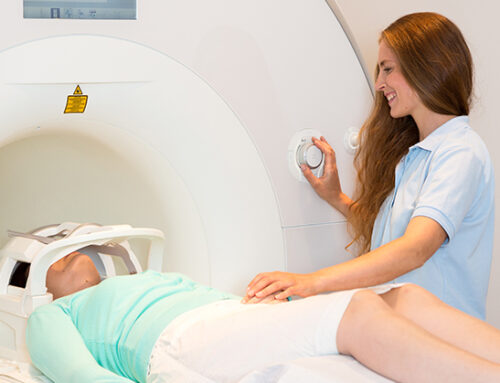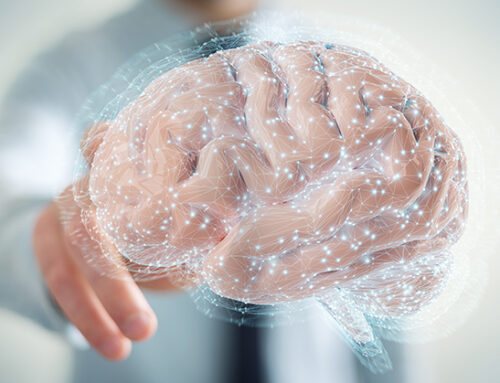Memory loss is the main symptom we associate with Alzheimer’s disease. What this looks like in real life is that dementia sufferers often can’t recall recent events and learning new information becomes a struggle.
It’s typically the first sign of the disease. The problems with thinking, reasoning, and language come later. But this isn’t always the case. As a result, there are people with very early Alzheimer’s disease who may chalk vision loss or speech problems up to aging, but they’re anything but.
While the underlying cause of Alzheimer’s continues to be debated, medical experts have largely agreed on the way it becomes established in the brain.
For example, decades before symptoms of memory loss make their first appearance, changes in the brain begin. This often looks like amyloid beta proteins building up and forming plaques in the temporal lobes, the areas involved with memory. Amyloid beta is then joined by another protein called tau which starts to form tangles.
Together these tangles and plaques damage tissues, causing them to wither and die. That’s when cognitive decline sets in. After inflicting damage to the memory centers of the temporal lobes, the disease spreads to other areas of the brain important for thinking and planning. But not always…
When Language And Vision Is Affected First
Sometimes, however, the area of the brain first impacted by the disease is not the memory centers in the temporal lobes, but areas of the brain that direct speech and vision. Why? Dr. Brian Gordon and his team at Washington University School of Medicine in St. Louis examined this issue.
“There are some rare, atypical forms of Alzheimer’s,” Dr. Gordon notes, “in which people first develop language or vision problems rather than memory problems. When you scan their brains, you see damage to the language or the visual areas, and not so much to the memory areas.
“[This] tells us that there are things we still don’t understand about how and why Alzheimer’s develops the way it does. There’s a reason why certain brain areas become damaged and not others, and we don’t know that reason yet. Every mystery we uncover with this disease pushes us closer to what we need to address it.”
To better understand why damage in the brain occurs where it does, Dr. Gordon and his team enrolled 350 Alzheimer’s patients in their study. The participants underwent brain scans to measure the amount and location of amyloid plaques and tau tangles, and the volumes of various brain areas.
The researchers compared the patterns of protein clumps and tissue damage in the volunteers to the gene expression patterns of APOE – the greatest genetic risk factor for Alzheimer’s – and other genes associated with Alzheimer’s disease.
Their findings revealed something very interesting.
Variation In Damaged Brain Areas Linked to Genes
Dr. Gordon’s team found that the parts of the brain where APOE is most active are the areas that sustain the most damage. This finding provides clues as to why symptoms of Alzheimer’s disease can vary so much from person to person. It also highlights an understudied aspect of Alzheimer’s disease that suggests yet-to-be discovered biological mechanisms may play an important role in the disease.
Dr. Gordon explains, saying, “There was a close match between where you see high APOE expression, and where you see tau tangles and tissue damage. And not just APOE. If you look at, say, the top 20 genes associated with Alzheimer’s disease, they are all expressed in the temporal lobes in similar patterns.
“There’s something fundamentally different about these regions that make them vulnerable to Alzheimer’s brain damage, and that difference is probably baked in from birth and influenced by a person’s genetics.”
12 Times More Likely To Get Alzheimer’s Disease
While every person carries some version of the APOE gene, people with the APOE4 variant are up to 12 times more likely to develop Alzheimer’s and develop it at a younger age. More amyloid beta accumulates, and mice studies show APOE4 also increases damage due to tau, even without amyloid present.
To assess the effect of the high-risk variant of APOE on tau-related brain damage in people, the researchers classified each participant as carrying the high-risk variant or not and analyzed the protein clusters and atrophy in their brains.
“APOE4 carriers are more likely to start accumulating amyloid, which puts them on the path to Alzheimer’s,” Dr. Gordon said. “Then, for the same amount of amyloid they get more tau tangles, which leads to more atrophy. It’s a double hit on the brain.”
Dr. Gordon and his team plan to continue to explore this issue.
“When we see someone who presents with vision problems, is there a specific genetic signature that corresponds to the areas that are damaged in the brain? We want to know why some people have these altered patterns and what it means about how Alzheimer’s disease develops and how it can be treated.”
My Takeaway
These findings make a lot of sense when you consider the research that reveals a large number of people who have a significant amount of beta amyloid proteins in their brains do not have Alzheimer’s disease. There is clearly another factor involved in the development of this memory-robbing disease. And I believe genetic risk factors are probably the tip of the iceberg in what research will eventually uncover.
What does it mean for you today?
It’s more important now than ever before to live the lifestyle that’s clinically proven to support a strong memory as you age, especially if you have a genetic predisposition to Alzheimer’s disease. This includes nourishing your brain with a diet rich in vegetables, fruit, lean meats, and healthy fats while avoiding processed foods and sugar. It’s also helpful to supplement with brain-supporting antioxidants and nutrients, to exercise, manage your stress level and sleep well.







